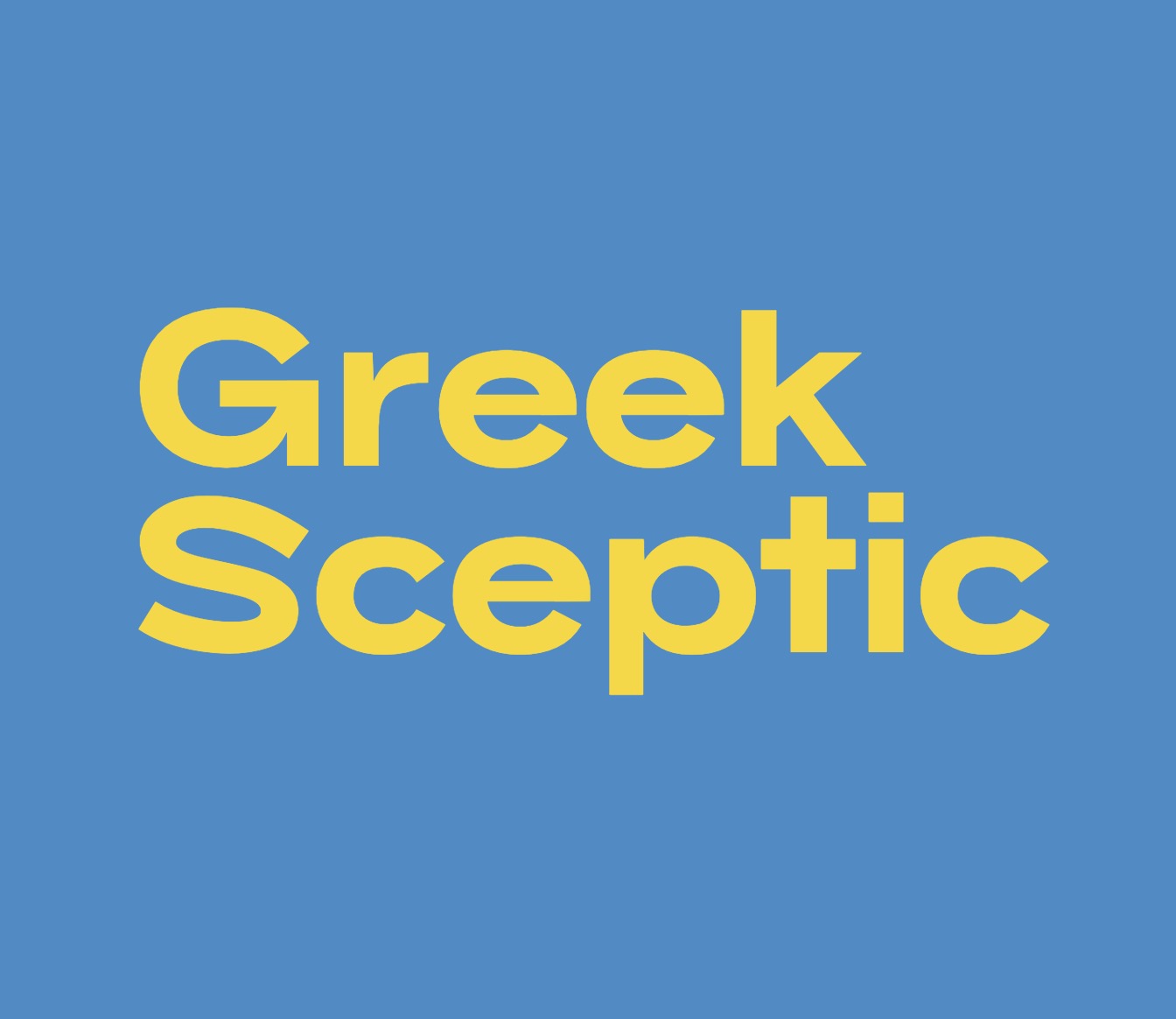Ancient Greek Skepticism and Mythology
Myths Reveal Humanity’s Deeper Truths
Discover how myths unveil our shared human experiences and values. Explore the hidden wisdom in ancient stories as Myths Reveal Humanity’s Deeper Truths.

Creation myths captivate us with their grand tales of the universe’s origins. These stories are more than just fiction. They offer insights into the human experience and our place in the world.
Cosmogonic myths serve as windows into our shared humanity. Through these narratives, we can explore the deeper truths that shape our understanding of existence.
These symbolic stories have long influenced our worldviews and origin stories. They reveal how different cultures make sense of life’s biggest questions.
Key Takeaways
- Creation myths are symbolic narratives that explain the beginning of the world within a particular tradition or community.
- These myths are central to shaping human orientation in the universe and the basic patterns of life and culture.
- Creation myths attempt to reveal humanity’s deepest truths, providing a framework for self-identity and worldview.
- Myths express our shared experiences, values, and even prejudices through imaginative storytelling.
- Understanding creation myths can offer insights into the cultural and psychological dimensions of human nature.
What is a Creation Myth?
Creation myths are powerful stories about humanity’s place in the world. They describe how the universe, Earth, and life began. These tales often involve supernatural beings and their extraordinary deeds.
Creation myths shape our understanding of the world. They guide our relationships with nature, spirituality, and each other. These stories reveal deep truths about human existence.
Definition and Purpose
Creation myths are philosophical and theological versions of primal myths. They tell of events from the “primordial Time” of beginnings. These stories show how reality came into existence through various characters’ actions.
These mythological narratives are more than just facts. They reveal central worldviews and frameworks for self-identity within societies. Creation myths help people understand their place in the world.
Structure and Common Features
Creation myths have distinct plots and characters who undergo transformative journeys. They’re set in a vague past called “at that time” (in illo tempore). This creates a sense of sacred history.
These mythological tales answer deep questions meaningful to their communities. They provide a birth story that defines humanity’s role in the world. Creation myths develop through oral traditions.
Multiple versions of these myths exist across diverse cultures. Yet, they share common elements reflecting their role in shaping worldviews. These stories guide how people relate to their environment and each other.
“Creation myths are the foundation of a culture’s worldview, providing a framework for understanding our place in the cosmos and relationship to the divine.”
Classification of Creation Myths
Mythology scholars have created various ways to group creation stories from different cultures. These groupings help us understand the diverse range of creation myths. One common system identifies five basic types of creation myths:
- Creation ex nihilo (from nothing)
- Earth-diver creation
- Emergence myths
- Creation by the dismemberment of a primordial being
- Creation by the splitting or ordering of a primordial unity
Another classification system focuses on common themes in creation stories. These themes include:
- A primeval abyss or chaos
- An originator deity
- A cosmic egg or embryo
- Life generated from the corpse or dismembered parts of an originator deity
These groupings reveal shared structures in creation myths from different traditions. They show patterns across vastly different geographical regions. By spotting these patterns, mythologists gain insights into universal human experiences.
These stories reflect how people view the world’s origin and humanity’s place in it. They help us understand the basics of human existence and cultural values.

“Myths are sacred stories reflecting and reinforcing a community’s worldview. They explain the fundamentals of human existence, purpose, and cultural values.”
Ex Nihilo: Creation from Nothing
The concept of ex nihilo is crucial to Judaism, Christianity, and Islam. It means God created the world from nothing. By the 3rd century CE, this idea became a key part of Christian belief.
Ancient Egyptian, Vedic, and animistic stories also feature ex nihilo creation. In these tales, a deity creates the world through speech, dreams, breath, or thought.
Abrahamic Traditions and Ex Nihilo
The creatio ex nihilo doctrine emerged around 200 A.D. It developed during debates with gnostics, Stoics, and Middle Platonists. This idea of God’s power to create from nothing became central to early Christian theology.
Ex Nihilo in Other Cultures
Many non-Abrahamic myths describe creation through a deity’s bodily secretions. The term “ex nihilo” can be flexible in these stories. It may involve changing a primordial substance rather than creating from absolute nothingness.
These varied cultural views show how humans try to grasp cosmic origins. They reflect our attempts to understand our place in the universe.
| Tradition | Creation Myth |
|---|---|
| Abrahamic | God creates the world out of nothing (ex nihilo) |
| Hindu | The world is brought into being through the bodily secretions of a creator deity |
| Animistic | The world is created through the speech, dream, breath, or pure thought of a creator |
“Myths have evolved over time to encompass time-tested themes that address human universals that permeate day-to-day life.”
The Milky Way: A Cosmic Roadmap
The Milky Way has sparked human imagination for centuries. It has inspired mythological stories across various cultures. Ancient Greeks, Romans, Andean peoples, and Māori have all attributed profound meaning to this celestial river.
Greek and Roman Myths
Greek mythology saw the Milky Way as Hera’s spilled milk. Romans called it “Via Lactea” or the “Milky Way”. These myths show how humans connect with the cosmos and find their place in it.
Rivers of Stars
Many cultures see the Milky Way as a celestial river. In India, it’s the “Heavenly Ganges”. China calls it the “Silver River”, separating star-crossed lovers.
Andean peoples view it as Mayu, a great river. The Māori and other Oceanic cultures see it as a river of stories or a sky shark.
These river myths show how we project earthly features onto the cosmos. They reveal our shared tendency to find meaning in the night sky.
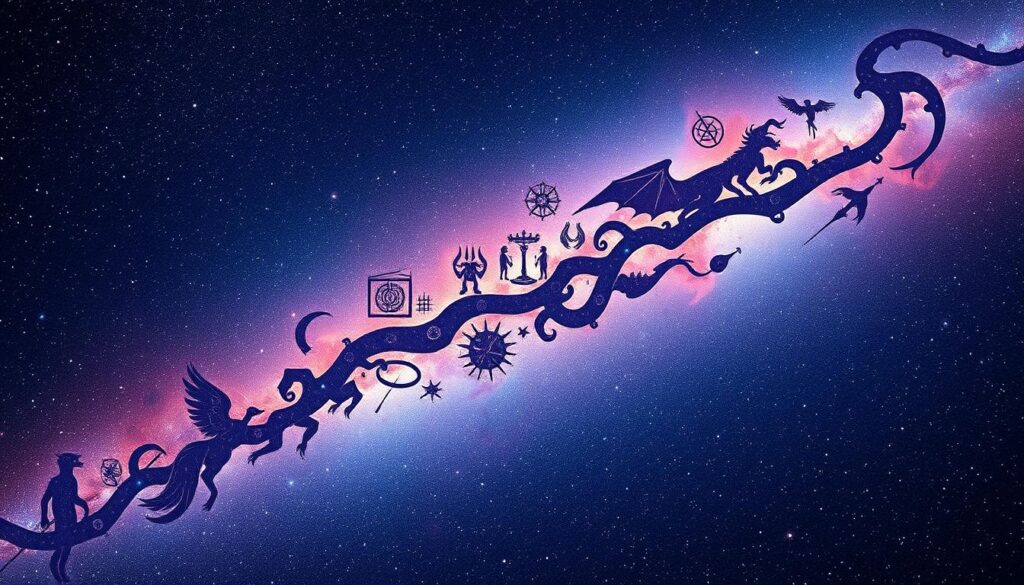
“The Milky Way inspires awe, humility, and a yearning for deeper understanding, instilling feelings of endless possibilities and infinite wisdom found in the cosmos.”
Myths Reveal Humanity’s Deeper Truths
Milky Way tales across cultures offer profound insights into shared human experiences. People worldwide use similar images to understand the cosmos. These stories reveal our universal need for meaning in the universe.
The galaxy is often seen as a celestial road, star river, or majestic animal. These shared motifs show how we connect nature with deeper meaning. They link us through our fascination with cosmic mysteries.
From California’s Chumash to New Zealand’s Māori, the Milky Way inspires wonder. Ancient Greeks and Amazon tribes share this fascination. These myths offer insights into experiences shaping our collective identity.
“The Milky Way is not just a collection of stars, but a tapestry of shared human mythology that binds us together across cultures and time.”
Milky Way myths showcase human cultural diversity and unity throughout history. They remind us we’re all part of a shared cosmic journey. Our awe of the universe unites us despite our differences.
These stories reflect our universal experiences and search for meaning. As we explore the cosmos, we see our myths as more than tales. They’re windows into our shared human experience.
Cooperation: The Key to Human Success
Anthropologist Agustín Fuentes’ research reveals cooperation as the secret to our species’ evolutionary success. His studies show that humans thrive through cooperation, not hostility. Our ability to work together has made us the dominant large animal on Earth.
The myth of an innate human “beast within” doesn’t hold up scientifically. Instead, our large brains and exceptional teamwork have driven humanity’s remarkable evolution. These factors, not aggression, explain our species’ incredible journey.
Aggression is Not Our Default
Compared to our closest primate relatives, aggression is rare in humans. Chimpanzees can be highly territorial and violent, attacking rival groups. In contrast, bonobos use peaceful, cooperative, and even sexual strategies to resolve conflicts.
Fuentes’ research shows cooperation trumps competition in human evolution. Our ancestors didn’t dominate through force. Instead, they excelled at collaborating, sharing resources, and building complex social structures. These skills drove our evolutionary success.
“Cooperation, not aggression, is the default mode that has allowed humans to thrive as the most successful large animal on the planet.”
| Characteristic | Chimpanzees | Bonobos | Humans |
|---|---|---|---|
| Territorial Behavior | Highly Territorial | Less Territorial | Cooperative Territoriality |
| Conflict Resolution | Violent Attacks | Sexual Conflict Resolution | Complex Social Structures |
| Evolutionary Success | Limited | Limited | Unprecedented |
Fuentes’ work dispels the myth of human aggression as our innate default. It highlights cooperation’s central role in our species’ remarkable evolution. This truth about human nature is crucial for navigating today’s complex challenges.

Debunking Myths About Human Nature
Research has disproven common beliefs about human nature. Aggression, strict gender roles, and racial divisions aren’t inherent human traits. These ideas are myths, not scientific facts.
The Myth of Race
Humans can’t be divided into distinct biological races. Geneticists have found no genetic basis for racial categories. This false idea has caused harm and hindered human understanding.
Race is a social construct, not a biological reality. It has fueled intolerance and created barriers to cooperation among people.
The Myth of Aggression
Humans aren’t naturally violent beings. Our ability to cooperate has been key to the success of human societies. The idea of an inner “beast” isn’t backed by science.
Believing aggression is natural can harm relationships. It may create fear and normalize abusive behavior.
The Myth of Sex Differences
Science doesn’t support the idea of fundamental biological differences between men and women. Humans can adapt to various social and sexual arrangements. The belief in fixed sex differences can harm gender relations.
This myth supports sexual inequality. It creates unrealistic expectations that people feel pressured to meet.
Challenging these myths leads to a better understanding of our shared humanity. It helps us work towards a world with more tolerance, cooperation, and equality.

Travel and Cultural Diversity
Traveling reveals the incredible diversity of successful ways of being human worldwide. From Micronesia to New Guinea, people’s adaptations and worldviews are awe-inspiring. Yet, we share unifying human experiences that connect us all.
We all seek meaning in the cosmos and create grand narratives. Humans cooperate to survive and prosper, regardless of cultural differences. These shared traits bind us together as a species.
Anthropologist Agustín Fuentes notes that travel shows both human diversity and common elements. New cultures may seem foreign at first. But by embracing cultural relativism, you’ll uncover the wisdom in these lifestyles.
| Destination | Unique Cultural Practices | Unifying Human Experiences |
|---|---|---|
| Micronesia | Canoe building, traditional navigation techniques, seafaring lifestyle | Storytelling, community-oriented values, connection to the natural world |
| New Guinea | Elaborate body adornment, ritualized exchange systems, communal decision-making | Belief in the sacred, reverence for ancestors, emphasis on cooperation |
| Europe | Diverse architectural styles, vibrant cultural festivals, deep-rooted culinary traditions | Appreciation for art and history, celebration of shared European heritage, sense of exploration and adventure |
Immersing in diverse cultural experiences shows the many successful ways of being human. You’ll witness ingenuity and resilience firsthand. From Micronesian canoe-building to New Guinea’s communal practices, human spirit shines.
Amidst diversity, unifying human experiences transcend boundaries. We all seek meaning and revere the sacred. Cooperation for survival is universal, binding us together despite outward differences.

“Travel reveals both the breadth of human variation and the common elements that bind us together.”
Keep an open mind as you explore the world. Embrace cultural relativism to truly appreciate human diversity. You’ll discover the successful ways of being human that help us thrive globally.
Observing Primates and Human Behavior
Anthropologist Agustín Fuentes closely observes primates to gain insights into human behavior. He uses Crittercam technology to capture unique glimpses of these animals’ daily lives. This innovative approach helps uncover new perspectives on our evolutionary origins.
Fuentes watches macaques navigate their environment, revealing surprising behaviors. He observes them pausing to watch traffic or gazing at scenic views. These observations challenge typical assumptions about primate behavior.
By studying organisms in their natural habitats, Fuentes seeks to understand human behavior better. This method helps him explore the true nature of our evolutionary foundations.
Crittercam Studies
Fuentes often uses Crittercam, a special camera system, in his research. It documents primates’ daily activities in their natural habitats. This technology provides a unique view into primate behavior and human-animal interactions.
Crittercam captures footage from the animals’ perspective. This reveals new perspectives on daily life that challenge common beliefs. Fuentes’ work with this tech has led to groundbreaking discoveries.
These studies offer insights into primate social dynamics and cognitive abilities. They also show how our closest relatives adapt to their environment.
“Watching a male macaque pause to observe the flow of traffic on a footbridge or position itself to gaze out over the Mediterranean provides insights that go beyond typical assumptions.”
Fuentes’ research transforms our understanding of human-primate relationships. His work with Crittercam technology sheds light on primate behavior complexities. It expands our knowledge and challenges what we think it means to be human.
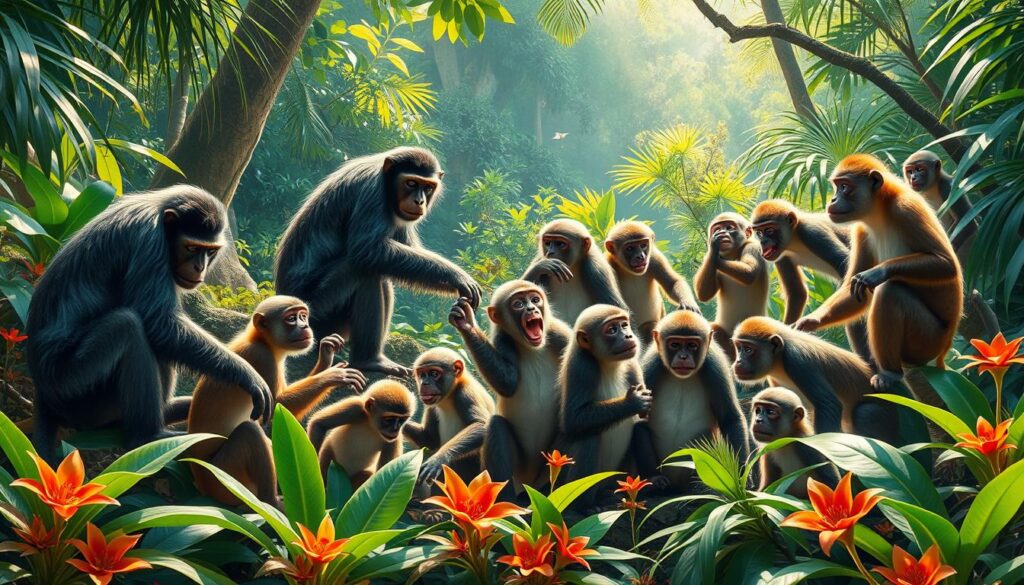
The Power of Myths in Everyday Life
Myths shape our behaviors, beliefs, and assumptions in powerful ways. They often stem from false ideas and incomplete information. These myths can have far-reaching historical consequences.
Consider the stereotype about men not asking for directions. It’s based on the myth of male spatial reasoning skills. This myth comes from the flawed “man the hunter” narrative, which lacks evidence.
Myths in everyday life can reinforce behaviors and justify prejudice. They’ve been used to deny women voting rights and rationalize racial segregation.
Fuentes exposes false assumptions and historical consequences of these myths. He challenges ingrained beliefs that perpetuate social injustice. His work shows how myths shape our lives and why questioning assumptions is crucial.
“Myths are not meant to be taken literally; they are metaphors representing the mysteries of existence and provide profound understanding of our internal journeys.”
Mythology bridges spiritual and philosophical realms. It offers a language for expressing deep spiritual truths beyond rational thought. By embracing myths, we can find deeper meaning and navigate life’s challenges.

Our society has suppressed the mythopoetic aspect of creativity. Fuentes reminds us of the myths in everyday life that shape our experiences. By challenging false assumptions and stereotypes, we can unlock myth’s transformative power.
Questioning Assumptions and Myths
Agustín Fuentes challenges our understanding of human nature. He uses anthropological insights to encourage evidence-based thinking. Fuentes urges us to move beyond simplistic explanations of the human experience.
Many “common sense” beliefs stem from incomplete information and cultural biases. Fuentes explores anthropology, biology, and psychology to debunk long-held myths. His work deconstructs assumptions dominating our collective consciousness.
“Humans cannot live without illusions, according to philosopher John Gray, who argues that an irrational faith in progress is necessary to combat nihilism.”
Fuentes’ research promotes open-mindedness and challenging the status quo. This approach helps us gain a nuanced understanding of human complexities. By re-examining our beliefs, we can refine our knowledge of humanity.
- Probability of humans living with illusions: Gray suggests that humans cannot live without illusions, implying a high likelihood that individuals hold onto unrealistic beliefs.
- Percentage of individuals relying on hope for a better future: Gray argues that an irrational faith in progress is necessary for combating nihilism, indicating that a significant portion of society may rely on this belief to move forward.
- Occurrence rate of questioning established beliefs: Gray’s book aims to challenge preconceived notions and conventional wisdom, suggesting that there may be a growing trend in questioning commonly accepted ideas.
- Comparison between humanists’ belief in progress and religious beliefs: Gray highlights that humanists cling to the concept of progress as a form of faith, echoing the intensity of religious beliefs in the past.
- Shift from action-oriented to contemplative life views: Gray discusses the traditional aim of life being contemplation rather than changing the world, indicating a shift in perspectives may be occurring in society.
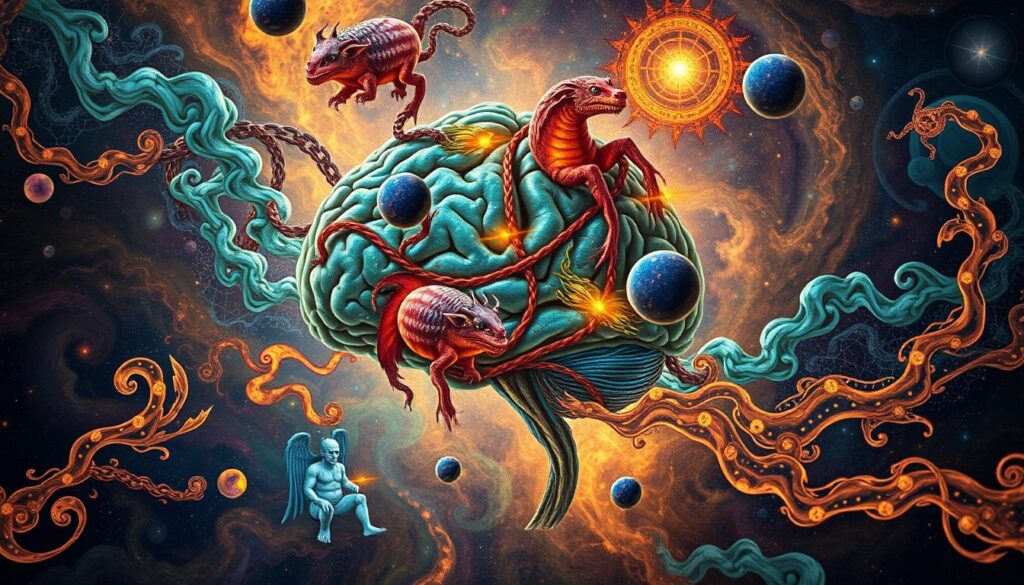
Fuentes’ approach helps us challenge our assumptions and broaden our perspectives. This commitment to challenging assumptions and critical thinking is crucial. It ensures our knowledge stays grounded in evidence and our beliefs continue to improve.
Conclusion
Myths reveal profound truths about human experience through symbolic narratives. They shape our worldviews, self-identity, and relationships with nature and spirituality. Examining creation myths and Milky Way mythologies offers insights into shared values and prejudices.
Anthropologist Agustín Fuentes challenges us to question our assumptions about human nature. He emphasizes cooperation as the foundation of our evolutionary success. This perspective helps us uncover deeper truths about the human experience.
Exploring myths invites us to see the world differently. It helps us understand our shared heritage and values. This exploration reveals the richness of the human spirit and our extraordinary potential.
FAQ
What are creation myths?
What are the common features of creation myths?
How are creation myths classified?
What is the concept of creation ex nihilo?
How have different cultures envisioned the Milky Way?
What does the research of Agustín Fuentes reveal about human nature?
What are some of the myths about human nature that Fuentes challenges?
How does Fuentes’ work encourage a more nuanced understanding of human nature?
Ancient Greek Skepticism and Mythology
Skepticism Vs Dogmatism: Who Really Holds the Truth?
I delve into the clash between skepticism and dogmatism, revealing how both shape our understanding of truth—what might you discover about your own beliefs?

When you weigh skepticism against dogmatism, it's clear that neither holds absolute truth. Skepticism thrives on questioning and open inquiry, encouraging you to explore various perspectives. It values evidence and promotes intellectual humility. In contrast, dogmatism clings to beliefs as undeniable truths, stifling adaptability and often resisting new information. While skepticism fosters a deeper understanding, dogmatism can lead to rigidity and misinformation. Balancing these two approaches can enrich your grasp of complex issues, guiding you toward a more nuanced understanding of truth. There's much more to uncover about how these ideas interact, so keep exploring!
Key Takeaways
- Skepticism encourages questioning and critical thinking, making it adaptable to new evidence, while dogmatism clings to rigid beliefs as absolute truths.
- Truth is viewed differently; skeptics see it as provisional and context-dependent, whereas dogmatists assert certain beliefs as unquestionable.
- A balance of skepticism and dogmatism fosters deeper understanding, promoting open-mindedness alongside necessary reference points for knowledge.
- Excessive skepticism can lead to cynicism, while dogmatism may result in misinformation and unchallenged assumptions, hindering progress.
- In contemporary contexts, skepticism is vital for assessing information credibility, especially in an era of misinformation and political polarization.
Understanding Skepticism
Skepticism is a philosophical approach that invites you to question the certainty of knowledge rather than accept beliefs at face value. By embracing skepticism, you learn to acknowledge the limits of what you can know.
There are two primary types of skeptics: Nescio, who genuinely seeks truth and recognizes their ignorance, and Nesciam, who justifies their lack of knowledge without pursuing understanding. This distinction shapes how you approach knowledge and inquiry. In various fields, such as projecting technologies, a skeptical mindset can help you discern the differences between essential features like color accuracy and contrast ratios that greatly impact image quality.
Central to skepticism is the concept of epoche, which encourages you to suspend judgment. This suspension allows you to refrain from making definitive assertions while you continue your quest for understanding.
Historical figures like Pyrrho laid the groundwork for this philosophy, emphasizing that true inquiry is crucial for distinguishing what can be known from what remains uncertain.
In your journey, skepticism serves as a powerful tool. It challenges dogmatic assertions and pushes you to question established norms and ideas continuously.
Defining Dogmatism

Dogmatism is all about holding certain beliefs as absolute truths without questioning them. This rigid mindset can provide comfort but often stifles intellectual growth and open dialogue.
Individuals displaying dogmatic traits may struggle to accept differing perspectives, leading to a lack of empathy in interpersonal relationships and potentially hindering effective communication in professional settings, such as in teamwork dynamics.
Let's explore the key characteristics of dogmatism and the implications these beliefs can have on our understanding of the world.
Characteristics of Dogmatism
At its core, dogmatism involves an unwavering belief in certain principles as absolute truths, often disregarding the need for evidence or critical inquiry. When you embrace dogmatism, you tend to prioritize adherence to established doctrines over questioning or examining your beliefs critically. This rigid mindset can create a framework of certainties that feels comforting but ultimately limits your intellectual growth and exploration.
Here's a quick look at some characteristics of dogmatism:
| Characteristic | Description |
|---|---|
| Absolute Certainty | Dogmatists believe anything that aligns with their views. |
| Resistance to Conflicting Evidence | They often dismiss evidence that contradicts their beliefs. |
| Rigid Mindset | A lack of flexibility in thought leads to inflexible positions. |
| Authority Over Inquiry | They favor established doctrines over personal investigation. |
In dogmatism, the static understanding of truth stifles meaningful discourse and limits critical thinking. This mindset can be found in various areas, including religious fundamentalism, where dissenting views are frequently dismissed outright. Understanding these characteristics helps you see how dogmatism can hinder your ability to engage with diverse perspectives.
Implications of Dogmatic Beliefs
How do dogmatic beliefs shape our understanding of the world? Dogmatism offers a rigid framework, presenting certain beliefs as absolute truths. This unwavering acceptance can provide you with a sense of certainty and purpose, but it often comes at a cost.
When you cling to dogmatic views, you might resist conflicting evidence, limiting your intellectual growth and adaptability. For instance, in religious fundamentalism, specific doctrines are held as indisputable, which can lead you to reject alternative perspectives. This tendency can stifle discourse, as dogmatism discourages questioning and critical analysis.
In contrast, skepticism thrives on inquiry and doubt, encouraging you to explore various knowledge claims. Additionally, embracing a more open mindset can enhance cognitive function and memory retention, as seen in the benefits of listening to classical music, which promotes relaxation and better mood regulation (enhances cognitive function).
The implications of dogmatic beliefs extend beyond personal understanding; they shape societal interactions and progress. By prioritizing certainty over curiosity, dogmatism can hinder the evolution of ideas and understanding.
If you embrace skepticism, you open the door to richer discussions and a more nuanced view of the world. Ultimately, while dogmatism may provide comfort, it can also create barriers that keep you from fully engaging with the complexities of life and knowledge.
The Nature of Truth

Truth is a slippery concept that sparks endless debate in philosophy. When you explore the nature of truth, you'll find two opposing views: skepticism and dogmatism.
Skeptics assert that absolute truth is unattainable, emphasizing the need for continual inquiry and adaptability. They argue that what you consider true can change based on new evidence or perspectives, highlighting that knowledge is provisional. This aligns with the idea that curiosity enhances problem-solving abilities through diverse perspectives, further supporting the skeptical approach to truth.
In contrast, dogmatism holds that certain beliefs are unquestionable truths, which can lead to intellectual stagnation. Dogmatists believe in definitive truths that don't require further scrutiny, often dismissing alternative viewpoints. This clash between skepticism and dogmatism illustrates the complexity of truth itself.
As you navigate these concepts, you'll recognize that the context in which you examine truth is essential. Different perspectives can greatly shift your interpretation and acceptance of what's considered true or false.
Ultimately, engaging with both skepticism and dogmatism allows you to appreciate the intricate nature of truth, urging you to reflect on your beliefs and the validity of those around you. Embracing this complexity fosters a deeper understanding of the world and your place within it.
Historical Perspectives

Why has skepticism persisted throughout history? You'll find that its roots trace back to ancient Greek philosophy, particularly through figures like Pyrrho. They emphasized inquiry and the suspension of judgment, especially as various philosophical doctrines emerged.
Skepticism often arises in response to social and political upheaval, serving as a tool for critical examination during chaotic times. Curiously, just as individuals seek clarity in their beliefs, many now turn to spiritual retreats for introspection and growth, highlighting a modern form of inquiry into personal truths.
As you explore historical contexts, you'll notice that skepticism acts as a counterbalance to dogmatism. For example, the debates between early Christian theologians and pagan philosophers highlight how skepticism challenged established beliefs, prompting deeper discussions about knowledge and faith.
Academic skeptics, especially those in the Platonic tradition, accepted some level of probabilism, while Pyrrhonean skeptics rejected certainty entirely.
Throughout history, skepticism has re-emerged during crises, urging individuals and societies to question established norms. You see this pattern repeatedly, as skepticism provides a way to navigate uncertainty and seek greater understanding.
When dogmatism asserts absolute truths, skepticism encourages you to dig deeper and consider alternative perspectives, allowing for a more nuanced view of reality. This ongoing dialogue shapes our understanding of truth and belief.
The Role of Inquiry

Inquiry serves as the backbone of skepticism, driving individuals to question their beliefs and assumptions. When you engage in genuine skepticism, you emphasize the importance of critical listening and openness to new evidence. This sets you apart from dogmatism, which clings to established beliefs and resists change. By practicing inquiry, you foster a deeper understanding of truth.
In a world where financial strategies evolve, understanding the nuances of options like a Gold IRA can be essential as you navigate retirement planning.
The concept of epoche, or suspension of judgment, plays a vital role in your inquiry. It allows you to explore ideas without prematurely committing to conclusions, paving the way for a thorough examination of different perspectives. In this space of inquiry, you maintain a hopeful attitude towards discovery, actively seeking knowledge and resisting complacency amid uncertainty.
Moreover, the tension between skepticism and dogmatism underscores the necessity of continual questioning and investigation. Each question you pose serves as a tool to uncover and refine truths in philosophical discourse.
Through this dynamic process, you not only enrich your understanding but also contribute to a culture that values inquiry over blind acceptance. Embracing skepticism and its role in inquiry can greatly enhance your pursuit of knowledge and wisdom.
Implications of Skepticism

Skepticism plays an essential role in promoting critical inquiry, pushing you to question the status quo and seek evidence for your beliefs.
It's vital to approach health claims, such as the health benefits of coffee, with a discerning mindset, as not all information is equally valid.
It helps you balance knowledge and ignorance, reminding you that uncertainty can lead to deeper understanding and growth.
Critical Inquiry Importance
Many people underestimate the power of critical inquiry, yet it's a cornerstone of skepticism that challenges established beliefs and encourages you to question the evidence behind claims. By engaging in critical inquiry, you explore various philosophical perspectives, allowing you to understand different viewpoints and the reasoning that supports them. This practice is essential in today's world, where misinformation can easily spread.
Additionally, incorporating witty literature quotes can provide humor and insight that enhance discussions around skepticism and critical thought.
Genuine skeptics embrace epoche, the art of suspending judgment, which keeps you open to new evidence and insights. This dynamic approach fosters a deeper understanding and appreciation of knowledge, as you recognize that what you know may always be subject to revision.
The distinction between Nescio and Nesciam reveals that while some seek the truth through inquiry, others may hide behind ignorance.
Skeptical inquiry promotes intellectual humility, urging you to acknowledge your limitations and biases in the quest for understanding. By actively engaging with skepticism, you cultivate a mindset that navigates the complexities of truth more adeptly, fostering a more nuanced appreciation of knowledge.
Ultimately, critical inquiry empowers you to challenge assumptions and seek a deeper understanding of the world around you.
Knowledge and Ignorance Balance
Balancing knowledge and ignorance requires a mindset that values ongoing questioning and self-awareness. When you embrace skepticism, you acknowledge that your understanding is always evolving. This perspective encourages you to confront your ignorance, fostering a genuine desire to seek truth through critical examination.
As a Nescio, you remain open to new ideas and insights, contrasting sharply with the Nesciam who justifies their ignorance. Additionally, adopting practices like mindfulness can help you remain present and aware of your thought processes, promoting a healthier approach to personal growth and understanding top wellness tips.
The practice of epoche, central to skepticism, allows you to suspend judgment. This neutrality helps you explore conflicting ideas without bias, leading to a more balanced understanding of knowledge. By questioning established beliefs, you create a dynamic interplay between knowledge and ignorance that promotes deeper exploration of truths and assumptions.
Skepticism acts as a counterbalance to dogmatism, challenging rigid beliefs and encouraging discernment. This discernment becomes essential in maneuvering the fine line between knowledge and ignorance.
Ultimately, by embracing skepticism, you cultivate a nuanced understanding of reality, one that acknowledges the limits of your knowledge and the vastness of what you still have yet to learn. This balance empowers you to grow intellectually and personally.
Challenges of Dogmatism

Dogmatism frequently presents significant challenges in both personal and intellectual growth. When you cling too tightly to specific beliefs, you often dismiss alternative viewpoints, which stifles critical inquiry. This unwavering commitment can create a framework of absolute certainties that hinders your ability to adapt to new information.
In the domain of education, for instance, this rigidity can impede the integration of personalized learning approaches that cater to diverse student needs and encourage innovation.
Consider these challenges:
- Resistance to conflicting evidence: Adhering strictly to dogmatic beliefs makes it hard to accept information that contradicts your views.
- Lack of adaptability: The rigidity of dogmatism limits your ability to engage constructively in discussions, leaving you stuck in a narrow perspective.
- Stifled inquiry: By ignoring skepticism, you miss out on the essential questions that drive intellectual exploration and growth.
In environments where dogmatism thrives—such as certain religious or scientific circles—individuals often avoid questioning established doctrines. This detachment can prevent you from understanding complex truths.
Balancing Perspectives

How can you strike the right balance between skepticism and dogmatism in your pursuit of knowledge? It's important to recognize that both concepts play significant roles in how you understand the world.
Skepticism encourages you to question assumptions, fostering an open-minded approach that allows for continuous inquiry. On the other hand, dogmatism can provide necessary certainty and reference points, helping you evaluate beliefs effectively.
Navigating between these two extremes is essential to avoid intellectual stagnation or blind acceptance. You need to critically examine your beliefs while being open to new ideas.
Contextual frameworks often influence the validity of truth claims, so it's necessary to remain flexible. This balance enables both skepticism and dogmatism to coexist, enriching your understanding of complex issues.
Establishing shared frameworks in discussions can further enhance this balance. By doing so, you create an environment where skeptics and dogmatists can communicate effectively.
This fosters productive debates and helps you appreciate differing perspectives on truth. Ultimately, achieving balance between skepticism and dogmatism leads to a more nuanced understanding of knowledge, allowing you to grow intellectually and personally.
Frequently Asked Questions
What Is the Difference Between Skepticism and Dogmatism?
Skepticism encourages you to question beliefs and seek evidence, while dogmatism pushes you to accept certain truths without doubt. Embracing skepticism fosters open-mindedness, whereas dogmatism often leads to intellectual stagnation and resistance to new ideas.
What Is the Difference Between Skepticism and Relativism?
Isn't it intriguing how skepticism questions knowledge while relativism claims truth is subjective? You seek evidence and clarity with skepticism, but relativism suggests every belief holds validity. Understanding this can deepen your critical thinking skills.
What Is the Paradox of Skepticism?
The paradox of skepticism lies in its self-defeating nature. You claim knowledge can't be certain, yet that assertion itself suggests you know something. This contradiction challenges your understanding of knowledge and belief's very foundations.
Which Philosopher Refuted Skepticism?
You might consider G.E. Moore as a philosopher who refuted skepticism. He emphasized common-sense beliefs, asserting that their certainty surpasses skeptical claims, challenging the notion that doubt should undermine our understanding of reality.
Conclusion
As you stand at the crossroads of skepticism and dogmatism, picture a vibrant tapestry woven with threads of inquiry and conviction. Skepticism invites you to explore the unknown, like a curious traveler peering into the misty horizon, while dogmatism wraps itself in a heavy cloak of certainty. Embrace the dance between these worlds, allowing the light of questioning to illuminate your path, and find harmony in the vibrant interplay of belief and doubt, where truth often flourishes.
Ancient Greek Skepticism and Mythology
Are We All Just Characters in a Myth? The Philosophical Debate Continues
Just as myths shape our identities, one must wonder: are we the authors of our own stories, or merely characters in a grand narrative?

You live within a tapestry of myths that shape your identity and how you perceive the world. These narratives offer explanations for existence, origins, and culture. Philosophically, it raises questions about free will and purpose—are you the author of your story or just a character in someone else's? Myths resonate deeply, connecting you to universal themes that reflect shared human experiences. They evolve with society, adapting to modern dilemmas and creating new narratives. Exploring this idea opens up discussions about identity, making you ponder your role in this ongoing story. There's much more to uncover in this fascinating debate.
Key Takeaways
- Myths provide frameworks for understanding identity and existence, suggesting we might all play roles in a larger narrative.
- The concept of archetypes in myths reflects universal human experiences, implying that individuals can embody these timeless characters.
- Philosophical debates on existence question whether life is a scripted narrative, akin to characters in a mythological tale.
- Modern myths in popular culture often mirror personal journeys, reinforcing the idea that individuals navigate their own mythic stories.
- Engaging with myths fosters empathy and connection, highlighting the shared human experience while questioning our roles within these narratives.
The Essence of Myths
Exploring the essence of myths reveals their profound role in shaping cultural identity and understanding. Myths serve as symbolic narratives that reflect how you and your community view yourselves, providing explanations for both natural and cultural phenomena. Creation myths, for instance, demonstrate humanity's quest to comprehend its origins and purpose, much like explorers who set out on journeys to discover new horizons and insights into existence the thrill of adventure. They address existential questions, helping you navigate the complexities of life and death.
Throughout history, myths have evolved from oral traditions to documented narratives, becoming integral in transmitting knowledge and cultural values across generations. The themes of creation, death, and the afterlife recur in myths, revealing a universal human struggle to make sense of existence and cope with mortality's fear.
Scholarly debate often surrounds the interpretations of these myths, especially as modern adaptations reflect contemporary values and societal norms. Yet, despite these shifts, the psychological essence of myths remains significant, tapping into the collective unconscious and resonating through archetypes that facilitate personal growth.
Historical Context of Myth-Making

Myths have always been more than simple stories; they're foundational narratives that frame human existence within various historical contexts. Throughout history, societies created myths to explain the creation of the world and natural phenomena, shaping their cultural customs. Initially, early anthropologists saw these myths as sacred and tied to religion. However, modern scholars highlight their relevance in addressing societal norms and existential questions.
The change from oral traditions to documented narratives marked a significant evolution in myth-making. This shift allowed myths to be preserved and reinterpreted across generations, ensuring their survival. Over time, historical figures like Jesus and Muhammad became enveloped in mythologized narratives, showcasing how myths can evolve from historical truths into modified tales.
Here's a quick overview of the historical context of myth-making:
| Aspect | Ancient Myths | Modern Interpretation |
|---|---|---|
| Creation of World | Explains origins | Reflects societal issues |
| Cultural Role | Defines customs | Addresses existential queries |
| Evolution | Oral to written | Adaptation in popular culture |
Through this lens, you can appreciate how myths continuously shape and reflect human experience.
Modern Myths in Popular Culture
Today's popular culture is a fertile ground for the emergence of modern myths, where narratives crafted through films, literature, and digital media capture the essence of contemporary societal values and challenges. You see this in the Marvel Cinematic Universe, which spins a modern mythos around superheroes, blending archetypal themes of heroism and sacrifice with current discussions on identity and morality.
In relationships, the dynamics of love and heartbreak often echo these mythological themes, as individuals navigate the complexities of connection and emotion, such as the importance of clear communication during a breakup the classy way to explain a breakup.
Popular culture also reinterprets ancient myths, as in adaptations like "Percy Jackson" and "The Hunger Games," weaving timeless themes of struggle and resilience into fresh storytelling frameworks.
Video games such as "The Legend of Zelda" and "God of War" incorporate mythological elements, allowing you to engage with and reinterpret classic narratives in interactive ways.
Moreover, the rise of social media platforms has accelerated the spread of modern myths, creating new cultural narratives that often mix fact and fiction. This shapes public perception and collective beliefs, illustrating how deeply modern myths are embedded in our daily lives.
Philosophical Implications of Myth

Myths shape how you view your reality, offering a framework to explore your identity and existence. They raise essential questions about who you're and how you fit into the larger story of life.
Myth as Reality Framework
A framework for understanding reality often emerges through the stories we tell, and myths play an essential role in this process. They address existential questions and reflect the collective beliefs that shape our moral compass.
By tapping into the collective unconscious, as Jung suggests, myths offer a way for you to connect with universal experiences that resonate across cultures. Just as individuals with borderline personality disorder may seek meaning through emotional narratives, myths can also help us navigate the complexities of human experience.
Here are some key aspects of myths as a reality framework:
- Existential Guidance: Myths provide insights into human existence and moral actions.
- Cultural Reflection: They adapt over time to address contemporary societal issues while maintaining core themes.
- Symbolic Narratives: Myths offer stories that navigate life's complexities, helping you understand your place in the universe.
- Universal Archetypes: They connect you to shared human experiences, fostering empathy and understanding.
- Behavioral Influence: Myths can guide individual and societal behavior based on the values they embody.
Identity and Existence Exploration
Exploration of identity and existence often leads you to the narratives embedded in myths, which serve as mirrors reflecting collective beliefs and values. In ancient times, myths were fundamental for understanding who you're and your place in the world. They offered frameworks for grappling with complex questions of purpose and morality, shaping societal norms and personal identities.
Furthermore, just as relationships evolve and require nurturing, so too does our understanding of identity—this is significant in fostering relationships that deepen bonds. Philosophers argue that these narratives provide deeper insights into human existence, addressing the existential dilemmas modern rationality often overlooks.
When you investigate the psychological aspects of myths, as proposed by Jungian theory, you discover how archetypes influence both personal identity and collective consciousness. These ancient stories continue to resonate today, suggesting that the narratives you construct about yourself are essential to understanding your identity in a contemporary context.
Myths and Human Identity

Countless cultures rely on foundational narratives to shape their identities, revealing how deeply intertwined myths are with our understanding of self. Myths don't just entertain; they reflect existential themes that resonate universally, influencing your perception of human identity. Understanding these cultural narratives can enhance your cultural intelligence, allowing you to navigate diverse perspectives more effectively.
Consider how myths impact you and those around you:
- Cultural Frameworks: Myths provide contexts for self-image and collective beliefs.
- Shared Experiences: Archetypes, like the hero's journey, illustrate common human values.
- Existential Reflection: They explore themes of creation, mortality, and what it means to be human.
- Adaptability: Myths evolve, mirroring societal changes and maintaining relevance.
- Personal Constructs: Your identity is shaped by the narratives prevalent in your culture.
These elements show that your human identity isn't just a personal endeavor; it's a reflection of larger narratives. By engaging with myths, you can better understand the roles you play in your own life and society.
As you navigate your identity, remember that these stories are more than mere tales—they're foundational to who you're and how you connect with the world.
The Future of Mythical Narratives

You've likely noticed how modern myths adapt to reflect today's cultural landscape, showing their relevance in films and literature.
For instance, contemporary artists often draw inspiration from literary themes, exploring identity and social issues through their work, which reflects the ongoing dialogue between tradition and modernity in the arts, as seen in the influence of literature on Bengali visual arts.
As society changes, these narratives evolve, offering fresh insights into our identities and challenges.
Let's explore how these adaptations shape our understanding of the human experience in a rapidly changing world.
Modern Myth Adaptation
As society evolves, modern myth adaptation emerges as a powerful reflection of contemporary values and concerns. You'll notice how ancient myths are reinterpreted in films and literature, resonating with today's audience.
These adaptations reveal the adaptability of myth-making, addressing existential themes and cultural anxieties, much like the evolution of personal artistic style that reflects changing societal contexts.
Consider these key aspects of modern myth adaptation:
- Reimagined Narratives: Old myths take on new forms, exploring current societal issues.
- Archetypal Characters: Familiar story arcs echo traditional myths, tapping into universal human experiences.
- Blending Genres: Popular media mixes various genres, creating fresh myths that resonate deeply.
- Digital Participation: Social media platforms allow everyone to contribute to myth-making, reflecting the collective psyche.
- Cultural Unification: Evolving myths foster community bonds, reinforcing shared identity and values.
Through these adaptations, you can see how narratives continue to shape our understanding of the world.
The ongoing evolution of myth in contemporary culture proves that it's not just relevant; it's essential for exploring human emotions and experiences in an ever-changing landscape.
Cultural Relevance Today
In today's rapidly changing world, the cultural relevance of mythical narratives remains crucial. You might find that modern myths, rooted in the tales of ancient people, continue to shape our understanding of identity and morality. As films, literature, and digital media evolve, they reinterpret these traditional narratives to address contemporary issues like climate change and mental health. This adaptability guarantees myths resonate with current dilemmas, serving as cultural touchstones that unify communities.
By engaging with these modern myths, you foster critical thinking and develop deeper connections to real-world challenges. They invite you to explore the complexities of existence in a society that can often feel overwhelming.
The blending of genres in contemporary storytelling makes these narratives more accessible, allowing diverse audiences to reinterpret ancient tales in light of present-day values and concerns.
Ultimately, mythical narratives aren't just relics of the past; they remain significant in maneuvering our collective human experience. As you reflect on the stories that shape your worldview, consider how these time-honored myths influence your understanding of the world today and into the future.
Frequently Asked Questions
Are All Myths Entirely Fictional?
Not all myths are entirely fictional. They often blend historical truths with imaginative narratives, reflecting cultural values and deeper realities. You can see how they adapt over time, revealing insights about societies and human experiences.
What Is the Relation of Myth to Philosophy?
As the saying goes, "Truth is stranger than fiction." Myths and philosophy intertwine, shaping your understanding of existence and morality. They offer frameworks for exploring deep questions about identity, reality, and the human experience.
Who Are the Main Characters in a Myth?
In a myth, you encounter gods, heroes, and mythical creatures, each embodying human traits. Characters like Zeus and Odysseus navigate challenges, reflecting cultural values and universal themes that resonate with your own experiences and growth.
What Are the 5 Characteristics of a Myth?
So, you think myths are just bedtime stories? Think again! They've got archetypal characters, moral lessons, cultural significance, existential themes, and an oral tradition that keeps our human quirks alive through generations. Fascinating, right?
Conclusion
As you navigate through the tapestry of myths, you realize they're not just stories—they're mirrors reflecting our shared human experience. Each thread weaves together history, culture, and identity, shaping how you see yourself and the world. While the debate about our existence as mere characters may continue, these mythical narratives offer a canvas for understanding life's complexities. So, embrace the myth, for it's in these tales that you might just find the essence of who you are.
Ancient Greek Skepticism and Mythology
Exploring the Intersection of Art and Philosophy in Hellenistic Thought
On a journey through Hellenistic thought, discover how art and philosophy intertwine to shape our understanding of beauty, identity, and emotion. What revelations await?

In Hellenistic thought, art and philosophy intersect to create a rich exploration of individual emotion and identity. You'll find philosophers like Plato and Aristotle examining beauty and morality through art. This period champions realism and emotional depth, as seen in iconic sculptures like the Venus de Milo. The blending of Greek and Eastern cultures further enhances this dialogue, inspiring diverse artistic expressions and literary innovations. These themes prompted reflections on existence that resonate deeply with modern discussions around ethics and creativity. If you're curious, there's so much more to uncover about their lasting impact on today's philosophy and art.
Key Takeaways
- Hellenistic art emphasized realism and emotional depth, reflecting philosophical themes of individualism and human experience.
- Philosophers like Plato and Aristotle explored the relationship between art, beauty, and morality, influencing artistic expression.
- Literary innovations during this period allowed for complex explorations of identity and emotional themes, often linked to philosophical ideas.
- The blending of Greek and Eastern cultures in major cities fostered new artistic styles and philosophical discourse, enriching both fields.
- Art served as a medium for expressing philosophical concepts, prompting reflections on existence, beauty, and morality in Hellenistic society.
Historical Context of Hellenism

The Hellenistic period, marked by the profound impact of Alexander the Great's conquests, reshaped the Mediterranean landscape from 323 BCE to 30 BCE. Following Alexander's death, his empire fragmented, leading to the rise of independent kingdoms like those of the Ptolemies in Egypt and the Seleucids in Mesopotamia.
These kingdoms didn't just dominate territories; they facilitated the spread of Greek civilization, mixing it with local cultures and governance systems. The era also saw an increasing awareness of health and well-being, paralleling the development of various natural remedies, such as the health benefits of rapeseed honey, which reflects the growing interest in holistic approaches to health.
You'd find that this era emphasized individualism and emotional expression, which stood in stark contrast to the collective identity that defined earlier Greek city-states. The cultural exchanges sparked by Alexander's conquests created a cosmopolitan worldview, allowing ideas and art to flow freely across regions.
During the Hellenistic period, the fusion of Greek and Eastern elements laid the groundwork for future advancements in philosophy, art, and science. This blending enriched both Greek civilization and the cultures it encountered, resulting in a vibrant tapestry of thought and creativity that would influence generations to come.
Philosophical Schools and Their Influence

Amidst the vibrant cultural exchanges of the Hellenistic period, several philosophical schools emerged, each offering unique insights into human existence and society. The Stoics, founded by Zeno of Kition, emphasized logic, ethics, and physics, shaping a worldview that encouraged rationality and emotional resilience.
In a similar vein, the power of online communities can foster such resilience by providing support and collaboration among members. In contrast, Epicureanism, founded by Epicurus, focused on individual happiness and the pursuit of pleasure as the highest good, advocating for moderation and introspection as pathways to fulfillment.
Cynics like Diogenes took a different approach, challenging societal norms and promoting a lifestyle of simplicity and virtue. Their public engagements sparked debates about morality and the nature of happiness, influencing Hellenistic literature and thought. These schools of thought attracted students from Greece and Rome, creating a cosmopolitan atmosphere in vibrant cities like Athens and Alexandria.
Moreover, the intellectual patronage from ruling dynasties, such as the Ptolemies and Seleucids, played an essential role in supporting these philosophical schools. This backing not only facilitated their development but also guaranteed their lasting impact on later Roman thought, weaving a rich tapestry of ideas that shaped the intellectual landscape of the time.
The Role of Aesthetic Philosophy
Aesthetic philosophy during the Hellenistic period explores the complex nature of beauty and the appreciation of art, inviting you to contemplate how subjective and objective experiences shape our understanding of aesthetics.
This era was marked by a deep examination of beauty, where philosophers like Plato and Aristotle laid the groundwork for later thought. They focused on the interplay between art, beauty, and morality, prompting you to ponder key questions about the nature of beauty itself.
Additionally, the emotional resonance found in art parallels the benefits of listening to classical music, which enhances cognitive function and promotes relaxation.
You'll find that the Hellenistic world emphasized individualism and emotional expression in art, leading philosophers to investigate how aesthetic experiences evoke both emotional and intellectual responses. This exploration allowed for a richer understanding of aesthetics, as it acknowledged both personal interpretations and universal qualities in art.
As you explore this period, you'll notice how the dialogue between art and philosophy enriched cultural discourse.
Artistic movements reflected the prevailing philosophical ideologies, demonstrating how aesthetic philosophy not only defined beauty but also shaped the emotional landscape of the time.
Ultimately, this intersection invites you to appreciate how deeply interconnected art and philosophy are in shaping our perceptions of beauty and aesthetic experience.
Artistic Expression and Emotional Depth

Artistic expression during the Hellenistic period stands out for its remarkable realism and emotional depth, inviting you to engage with art on a more personal level. Unlike the idealized forms of the Classical era, Hellenistic art captures the intricacies of human emotion and experience.
You'll find that sculptures, like the Venus de Milo, blend ideal beauty with authentic human traits, making them relatable. This period also parallels the way certain food presentations, like crab cakes, combine traditional elements with innovative touches to evoke deep sensory connections.
Consider these elements that enhance emotional engagement in art in the Hellenistic period:
- Realistic Sculptures: They depict not just beauty but also vulnerability and emotion.
- Chiaroscuro Techniques: The use of light and shadow in painting adds depth, drawing you into the scene.
- Dramatic Architecture: Open spaces and dynamic designs evoke feelings, creating immersive environments.
- Elaborate Pottery: Colorful and ornate, these pieces reflect individual artistic sensibilities and cater to elite tastes.
In this context, art in the Hellenistic period becomes a powerful medium for expressing complex emotions, allowing you to connect deeply with the works and their creators.
Interplay Between Art and Philosophy
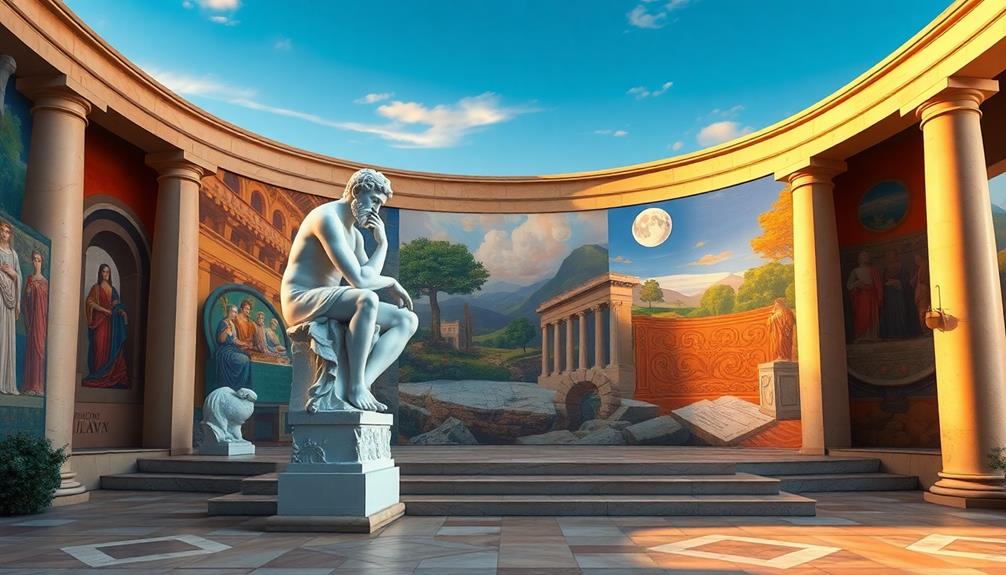
In the Hellenistic period, art and philosophy weren't just separate disciplines; they influenced each other in profound ways.
Artists often employed witty literature quotes to convey complex philosophical ideas, adding layers of meaning to their work.
You'll see how artists embraced philosophical themes, reflecting personal fulfillment and ethical exploration in their work.
This interplay not only shaped artistic expression but also invited viewers to engage with deeper questions about identity and morality.
Artistic Expression and Philosophy
Hellenistic thought reveals a profound interplay between art and philosophy that shaped the cultural landscape of the era. During this time, artistic expression became a powerful vehicle for conveying philosophical ideas, reflecting the complexities of individual experience and emotion.
This connection can also be seen in the way folklore and mythological themes were integrated into artistic forms, often depicting iconic monsters in various cultures that symbolize deeper moral lessons. You can see this connection in various forms of art, such as sculptures and literature, where the human condition is explored deeply.
- Emotional realism in works like the Venus de Milo emphasizes individuality.
- Techniques like chiaroscuro and perspective enhance the perception of reality.
- New literary genres, including drama, allow for complex philosophical exploration.
- Philosophers, like the Stoics and Epicureans, engaged with art to discuss ethics and virtue.
This interplay between artistic expression and philosophical thought invites you to reflect on essential questions about existence, identity, and morality.
The art of the Hellenistic period doesn't merely depict the world; it invites you to engage with profound inquiries about what it means to be human. By examining these works, you'll uncover a rich dialogue that continues to resonate with contemporary thought, bridging the gap between aesthetics and philosophical reflection.
Philosophical Themes in Art
Exploring philosophical themes in art reveals how deeply intertwined these two domains became during the Hellenistic period. In this era, art wasn't just about aesthetics; it served as a vehicle for expressing complex ideas about individualism and emotional depth.
Take the Venus de Milo, for instance. This sculpture embodies the philosophical quest for personal fulfillment and the richness of the human experience, which resonates with contemporary discussions of meaning and existence in philosophical investigation.
The rise of new literary genres, like comedy and pastoral poetry, also examined these philosophical themes. Playwrights such as Menander investigated identity and family dynamics, reflecting the societal norms of the time.
Schools of thought like Stoicism and Epicureanism played a significant role in shaping artistic intent. Stoics emphasized virtue and harmony, while Epicureans focused on pleasure and emotional resonance, informing the artistic expressions of the Hellenistic Age.
Artworks from this period are visual inquiries that invite you to contemplate beauty, morality, and existence. The interplay between aesthetics and philosophy fostered a culture where increased realism in sculpture mirrored evolving philosophical discussions on human emotion, allowing you to engage with the deeper questions of life.
Major Literary Contributions

The literary landscape of the Hellenistic period flourished with a diverse array of genres that captivated audiences and shaped future writing. This era emphasized individualism, delving into personal experiences and emotions, which marked a shift from the collective themes of earlier periods.
Notable contributions included:
- Callimachus: A prolific poet known for over 800 works, blending mythological and personal themes.
- Theocritus: Renowned for pastoral poetry that celebrated rural life, reflecting a deep connection to nature and simplicity, similar to how Montessori toys encourage exploration of the natural world.
- Menander: A groundbreaking playwright who introduced new comedic themes centered on individual and family life, mirroring the evolving social dynamics.
- Plutarch: An author of biographies and historical narratives that intertwined philosophical insights, paving the way for future prose genres.
These literary genres not only enriched the culture of the time but also laid the groundwork for later Roman writers and the broader development of Western literature.
The emotional depth and sophistication in Hellenistic works resonate today, showcasing the era's lasting impact on narrative and poetic forms.
Scientific Advancements and Their Impact
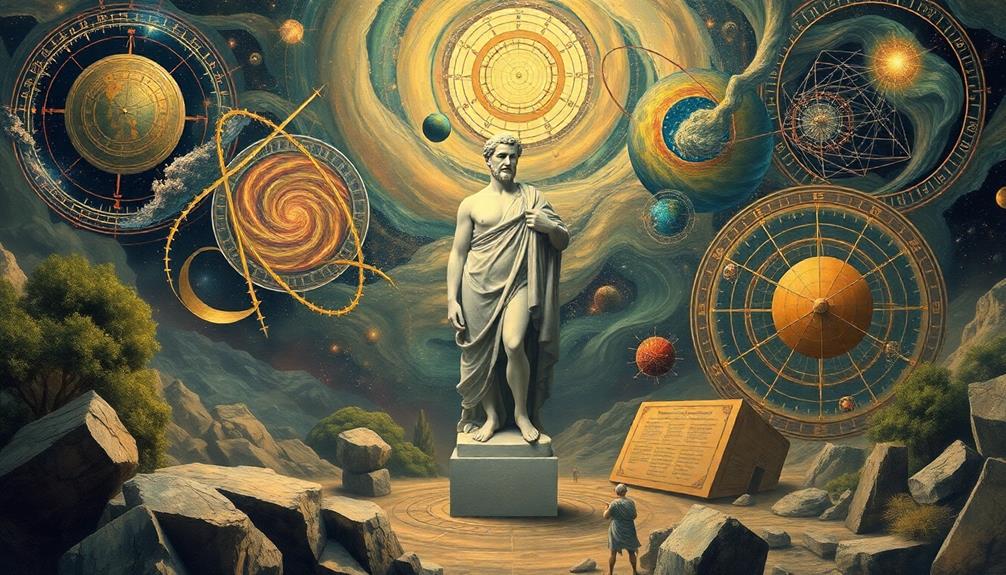
During the Hellenistic period, scientific advancements transformed our understanding of the world and laid the groundwork for future exploration in various fields. Think about Euclid's "Elements," which established a systematic approach to geometry. This work became the standard textbook for mathematics for over 2,000 years, influencing countless scholars and intellectual pursuits.
Furthermore, the integration of scientific principles into everyday life, such as the development of air purification technologies, reflects the Hellenistic spirit of inquiry and innovation.
Then there's Apollonios of Perge, who greatly advanced the study of conic sections, developing terminology and methods that future mathematicians would build upon.
Archimedes of Syracuse made groundbreaking discoveries that changed mathematics and engineering, particularly with principles of buoyancy and the invention of the Archimedean screw for lifting water.
Ktesibios of Alexandria showcased the innovative spirit of Hellenistic engineering through his hydraulic machines, like water clocks and pneumatics.
Hipparchos revolutionized astronomy with systematic observations and predictive models, laying a foundation that would guide astronomers like Ptolemy.
These scientific advancements didn't just enhance knowledge; they sparked new intellectual pursuits that shaped the very fabric of Hellenistic thought, merging art and philosophy with science in ways that still resonate today.
Cultural Exchanges and Cosmopolitanism
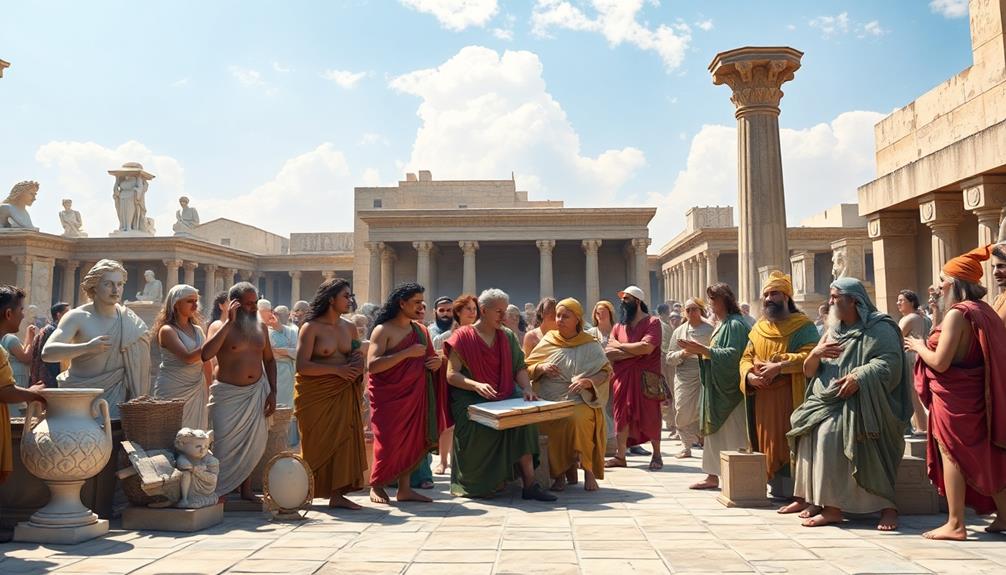
Cultural exchanges thrived in the Hellenistic period, reshaping art and philosophy as Greek culture mingled with diverse traditions across the Mediterranean and beyond. This era of cosmopolitanism transformed major cities like Alexandria into vibrant melting pots where various cultures interacted, leading to innovative artistic expressions and philosophical ideas.
The impact of sustainable materials on contemporary art practices can be traced back to these early exchanges, as artists began to explore new techniques and materials inspired by the diverse cultures they encountered. You can see this blending of influences through:
- The fusion of Greek and Eastern artistic styles in sculpture and painting.
- The collaboration between scholars and artists, encouraged by patrons from the Macedonian court and the Seleucid dynasty.
- The establishment of new cities that facilitated trade, featuring grid-pattern layouts and Greek amenities.
- The rise of mystery cults and new deities from Egypt and Syria, enriching the cultural landscape and inspiring artistic themes.
These cultural exchanges not only fostered a sense of community among diverse populations but also encouraged the exploration of new ideas.
As a result, the Hellenistic world became a rich tapestry of thoughts and expressions, showcasing how the relationship between art and cultural significance can lead to profound creativity and insight in art and philosophy.
Lasting Legacy of Hellenistic Thought

As you explore the lasting legacy of Hellenistic thought, you'll see how philosophical foundations shaped art and culture.
The ideas of Stoicism and Epicureanism not only influenced individual fulfillment but also left a mark on modern philosophical discourse.
This rich exchange of concepts continues to resonate in contemporary discussions around ethics and creativity.
Philosophical Foundations of Art
Hellenistic thought laid a rich philosophical groundwork that profoundly shaped the art of its time and beyond. The era's philosophical foundations emphasized individualism and emotional expression, directly influencing artistic representations. Artists prioritized realism and dramatic themes, creating works that resonated with viewers on a personal level.
Consider these key influences:
- Stoicism: Promoted virtue as the highest good, leading to depictions of moral integrity and harmony with nature.
- Epicureanism: Emphasized personal happiness, inspiring artists to explore themes of pleasure and the beauty of everyday life.
- Cultural Blending: The fusion of Eastern and Western elements introduced new techniques, such as chiaroscuro and perspective, enhancing visual depth.
- Aesthetic Inquiry: Hellenistic thinkers engaged deeply with questions of beauty, paving the way for future philosophical exploration of art's impact on human experience.
These elements collectively advanced the narrative of art, allowing it to reflect both societal values and the complexities of human emotion.
This legacy continues to inform our understanding of art and philosophy today, showcasing the enduring power of Hellenistic thought.
Influence on Modern Thought
The philosophical insights of the Hellenistic era have left an indelible mark on modern thought. You can see the influence of Hellenistic kingdoms in the emphasis on individualism and emotional expression that shapes contemporary philosophical discussions about self and identity. Think about how schools like Stoicism and Epicureanism introduced concepts of personal ethics and happiness. These ideas resonate with today's debates on well-being and morality.
Moreover, Hellenistic advancements in aesthetics, particularly regarding beauty and emotional depth in art, laid the groundwork for modern artistic movements and critiques. As you explore today's multicultural interactions, you'll notice the cosmopolitan worldview that emerged from the blending of Ancient Greek and Eastern cultures during the Hellenistic period.
Philosophical inquiries concerning nature and virtue from this era remain central to modern debates in ethics, environmental philosophy, and the philosophy of art.
This enduring legacy invites you to reflect on how Hellenistic thought continues to shape your understanding of art, ethics, and personal identity in our complex, interconnected world.
Frequently Asked Questions
What Is the Main Idea of Hellenistic Philosophy?
Hellenistic philosophy centers on personal ethics and the pursuit of happiness. You'll find key schools like Stoicism, which values virtue, and Epicureanism, which promotes pleasure and tranquility, shaping how you approach life's challenges.
How Did Hellenistic Culture Influence Art?
When it comes to Hellenistic culture, you'll find art bursting with realism and emotion. Artists embraced individuality, using new techniques and dynamic forms, creating pieces that resonate deeply, drawing you into their expressive world.
What Values Do Hellenistic Literature, Philosophy, and Art Share?
Hellenistic literature, philosophy, and art share a deep focus on individual experience, emotional expression, and ethical dilemmas. You'll notice how they explore beauty, fate, and the human condition, creating a rich, interconnected cultural tapestry.
How Are the Arts and Sciences of the Hellenistic Era Connected?
Imagine a modern fusion of art and science; in the Hellenistic era, you'd see artists using geometry and anatomy to create lifelike sculptures and paintings, emphasizing that creativity and scientific inquiry were deeply interconnected pursuits.
Conclusion
In exploring the intersection of art and philosophy in Hellenistic thought, you can see how these ideas wove together like threads in a rich tapestry. Imagine a vibrant marketplace, where a philosopher and an artist share ideas under the warm sun, each enriching the other's work. This synergy not only shaped the cultural landscape of their time but also left a lasting legacy that continues to inspire us today, reminding you of the power of collaboration in creativity.
-

 Health4 months ago
Health4 months agoUnderstanding Running Dry: Dive into Its Meaning
-

 News4 months ago
News4 months agoUnlock Your Potential with Biohacking Essentials
-

 News4 months ago
News4 months agoUnlock the Mystery of Sonoluminescence Today!
-
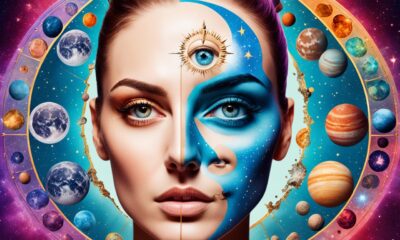
 News4 months ago
News4 months agoStar Appeal: Can Astrology Predict Your Hotness?
-

 Health4 months ago
Health4 months agoStairmaster vs Running: Calorie Burn Compared
-

 News4 months ago
News4 months agoDebunking Myths: J.D. Vance and His Unique Quirks
-

 News4 months ago
News4 months agoUnlock Quorum Sensing Secrets – Communication in Bacteria
-

 Health4 months ago
Health4 months agoLow-Calorie Fruit Dip: Cool Whip Delight
